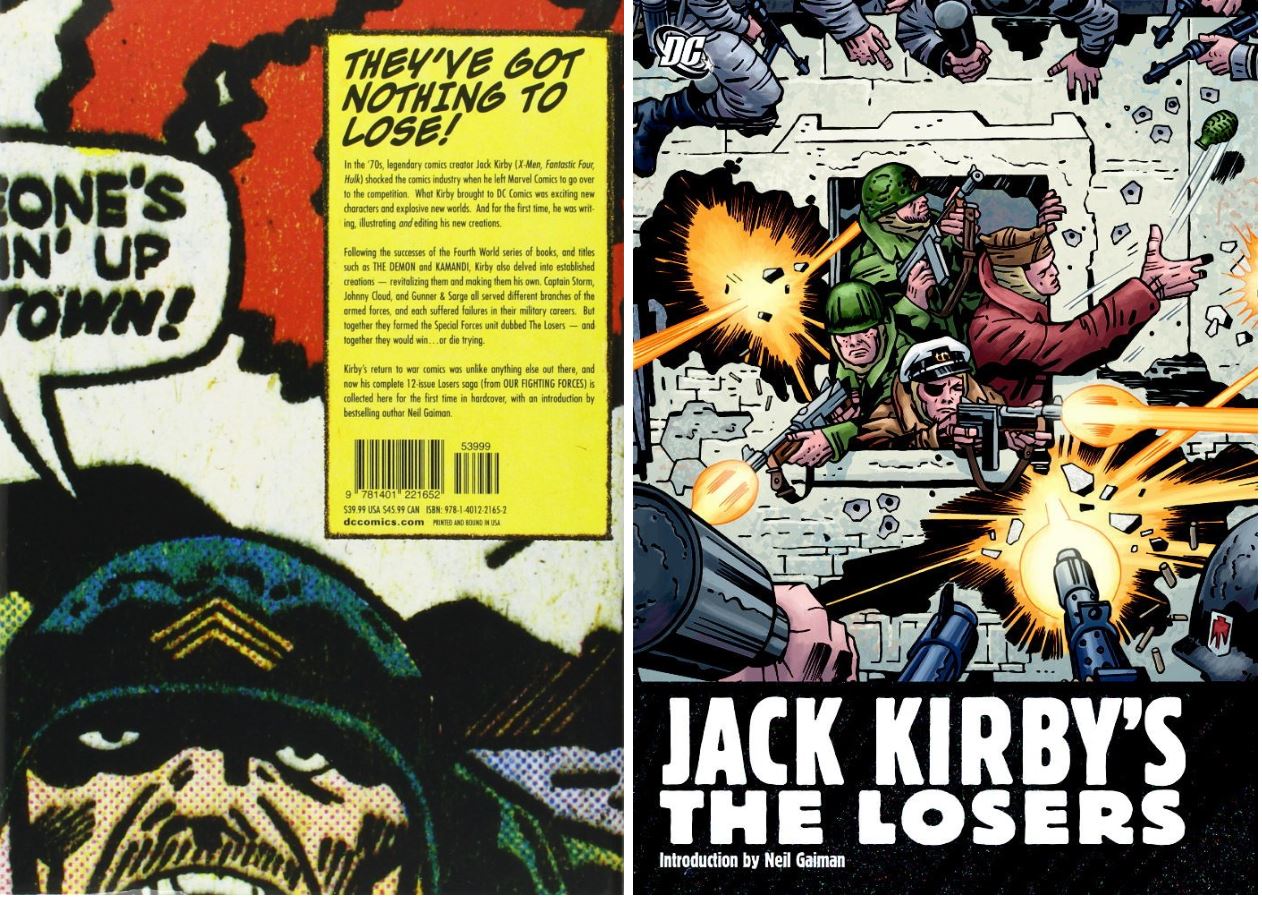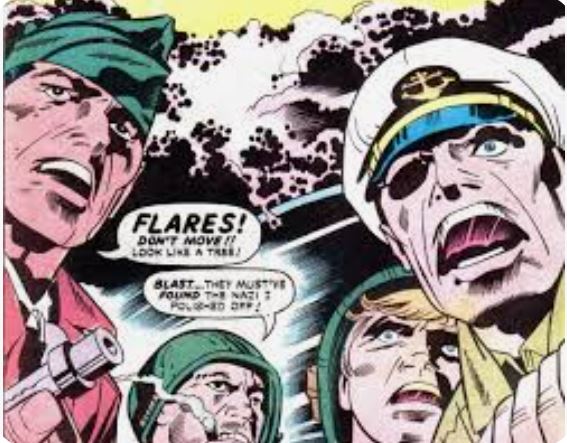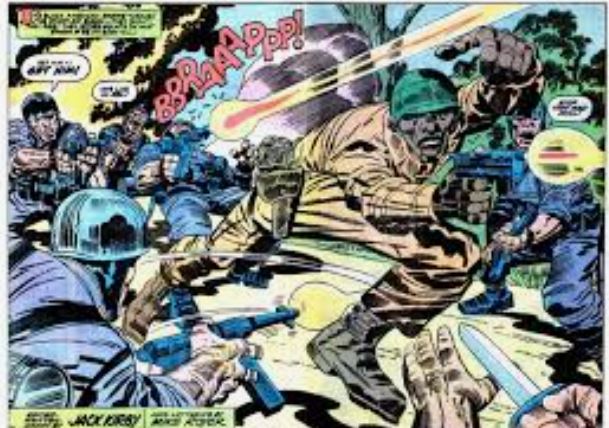
By Jack Kirby with D. Bruce Berry, Mike Royer & various (DC Comics)
ISBN: 978-1-84856-194-6 (HB)
This book includes Discriminatory Content produced in less enlightened times.
Despite there being a glorious profusion of Jack Kirby material around these days, much of the best and rarest stuff is still – unforgivably – hard to access. This astounding collection of his too-brief run on DC war comic Our Fighting Forces is, for far too many, an unknown delight. You can still find it in the original 2009 hardback edition, but as far as I know, there’s neither digital nor even n trade paperback edition – in English – to satisfy the desires of fans lacking an infinite bank balance.
Famed for his larger than life characters and gigantic, cosmic imaginings, the King was a decent, spiritual man from another generation, and one who had experienced human horror and bravery as an ordinary grunt during World War II. Whether in the world-weary Verité of his 1950s collaborations with Joe Simon or the flamboyant bravado of his Marvel creation Sgt. Fury, Kirby’s combat comics always looked and felt real: grimy, tired, battered yet indomitable. Back in 1974, with his newest creations inexplicably not setting any sales records at DC, and while he tentatively pondered a return to Marvel, Jack took over the creative chores on a well-established, compelling but always floundering series that had run in Our Fighting Forces since 1970.
The Losers were an elite unit of American warriors cobbled together by amalgamating three pre-existing war series that had reached the end of their solo star roads. Gunner and Sarge (supplemented by “Fighting Devil Dog” Pooch) were Pacific-based Marines; debuting in All-American Men of War #67, (March 1959). They patrolled for 50 issues in Our Fighting Forces (#45-94, May 1959- August 1965), whilst Captain Johnny Cloud – Navajo Ace and native American fighter pilot – shot down his first bogie in All-American Men of War #82 (December 1960) and flew (mostly) solo until issue #115 in 1966. The final component of the Land/Air/Sea team was filled by Captain Storm, a disabled PT Boat commander (he had a wooden leg) who had his own 18-issue title from 1964 to 1967. All three series were created by DC’s comics warlord Robert Kanigher.
The characters had all pretty much passed their sell-by dates when they teamed-up as guest-stars in a Haunted Tank tale (G.I. Combat #138 October 1969), but these “Losers” found a new resonance together in the “relevant-era” and disillusioned, cynical Vietnam years and beyond, when their nihilistic, doom-laden anti-hero adventures claimed lead spot in Our Fighting Forces #123 (January/February 1970). Once again written primarily by Kanigher, these episodes were graced with art from such giants as Ken Barr, Russ Heath, John Severin, Sam Glanzman, Ross Andru and Joe Kubert. With the tagline “even when they win, they lose” the squad saw action all over the globe, winning critical acclaim and a far-too-small, passionate following.
In an inexplicable dose of company politics, discontented Kirby was abruptly given complete control of the series with #151 (November 1974). His radically different approach was highly controversial at the time, but the passage of years has granted a fairer appraisal and whilst never really in tune with the aesthetic of DC’s other war-books, the King’s run was a spectacular, bombastic and singularly intriguing examination of the human condition under the worst of all possible situations.
The combat frenzy kicks off in ‘Kill Me with Wagner’ as The Losers infiltrate a French village to rescue a concert pianist before the Nazis can capture her. The hapless propaganda pawn has one tremendous advantage – nobody knows what she looks like. As with most of this series, a feeling of inevitable, onrushing Gotterdammerung permeates the tale: a sense that worlds are ending and a new one’s coming. The action culminates in a catastrophic wave of destruction that is pure Kirby bravura…

Most of DC’s war titles sported Kubert covers, but #152 featured the first in a startling sequence of hypnotic Kirby collations – almost abstract in delivery – to introduce the team to the no-hope proposition of ‘A Small Place in Hell!’ when they find themselves the advance guard for an Allied push, but dropped in the wrong town: one that has not been cleared…
The spectacular action here is augmented by a potent 2-page Kirby fact feature: Sub-machine guns of WWII, and it should be noted and commended that this collection is also peppered with un-inked Kirby pencilled pages and roughs.
Our Fighting Forces #153 is one of those stories that made traditionalists squeak. Behind a Kirby cover, the story of ‘Devastator vs. Big Max’ veers dangerously close to science fiction, but an admittedly eccentric plan to destroy a giant German rail-mounted super-cannon isn’t any stranger than many schemes actual boffins dreamed up to disinform the enemy during the actual conflict, actually…
That yarn – with two beautiful info-pages on military uniforms and insignia – is followed by a superb parable examining personal honour. A compelling Kirby cover segues into the team’s deployment to the Pacific to remove a Japanese officer whose devotion to ‘Bushido’ inspires superhuman loyalty and resistance to surrender among his men. The means used to remove him are far from clean or creditable…
Bracketed by 2 pages on war vehicles plus a wonderful pencil cover-rough, two more on artillery pieces and the pencils for the cover to that issue, OFF #155’s ‘The Partisans!’ takes the Losers into very dark territory, before they return to America for ‘Good-bye Broadway… Hello Death!’, wherein the boys experience home-front joys of New York whilst hunting a notorious U-Boat commander. Naturally there’s more to the story than first appears…
This fast-paced thriller is complemented by a history of battle headgear and another pencilled rough. Comprising a 2-part saga concerning theft, black marketeering and espionage, #157 & 158 introduce utterly unique personage ‘Panama Fattie!’ Her criminal activities almost alter the course of the war; and conclude in the highly charged ‘Bombing Out on the Panama Canal’, with accompanying pages on ships, subs and Nazi super-planes.
Behind the last Kirby cover (#159), ‘Mile-a-Minute Jones!’ details a smaller-scaled duel. With the Losers relegated to subordinate roles, the tale of a black runner who embarrassed the Nazis at the 1936 Olympics unfolds as a forced rematch with the Nazi ubermensch he defeated back then reignites old passions on the battlefield.

Indicating that Kirby’s attentions were being diverted elsewhere, Kubert & Ernie Chan handled the last three covers of this run, but the stories remain powerful, deeply personal explorations of combat. In ‘Ivan’ (OFF #160) the squad goes undercover, impersonating German soldiers on the Eastern Front, and have an unpleasant encounter with Russian Nazi sympathizers whose appetite for atrocity surpasses anything they have ever seen before. Supplemented by a 2-page tanks feature, the drama resumes in the hellish jungles of Burma which prove an unholy backdrop for traumatic combat shocker ‘The Major’s Dream’ before the volume and Kirby’s DC war work ends in a sly tribute to his 1942 co-creation Boy Commandos.
‘Gung-Ho!’ sees a young Gunner training a band of war orphans in Marine tactics, only to find fun turn to dire necessity after Germans overrun their “safe” position. This is an optimistic, all-out action romp ending on a note of hope and anticipation, even as the King made his departure for pastures not-so-new. From OFF #163 Kanigher picked up where he left off, with artists like Jack Lehti, Ric Estrada & George Evans illustrating, as the Losers returned to their pre-Kirby style and status, with readers hardly acknowledging the detour into another kind of war.
Jack Kirby is unique and uncompromising. If you’re not a fan or simply not prepared to see for yourself what all the fuss has been about then no words of mine will change your mind. That doesn’t alter the fact that his work from 1939 onwards shaped the entire American comics scene, affected the lives of billions of readers and thousands of creators in all areas of artistic endeavour around the world for generations, and which still garners new fans and apostles from the young and naive to the most cerebral of intellectuals. Jack’s work is instantly accessible, irresistibly visceral and deceptively deep whilst being simultaneously mythic and human.
These tales of purely mortal heroism are in many ways the most revealing, honest and insightful of Jack’s incredibly vast accumulated works, and even the true devotee often forgets their very existence. As Neil Gaiman’s introduction succinctly declaims, “they are classic Kirby” and even if you don’t like war comics, you may be in for a surprise…”
You won’t want to miss that, would you?
© 2009 DC Comics. All Rights Reserved.
